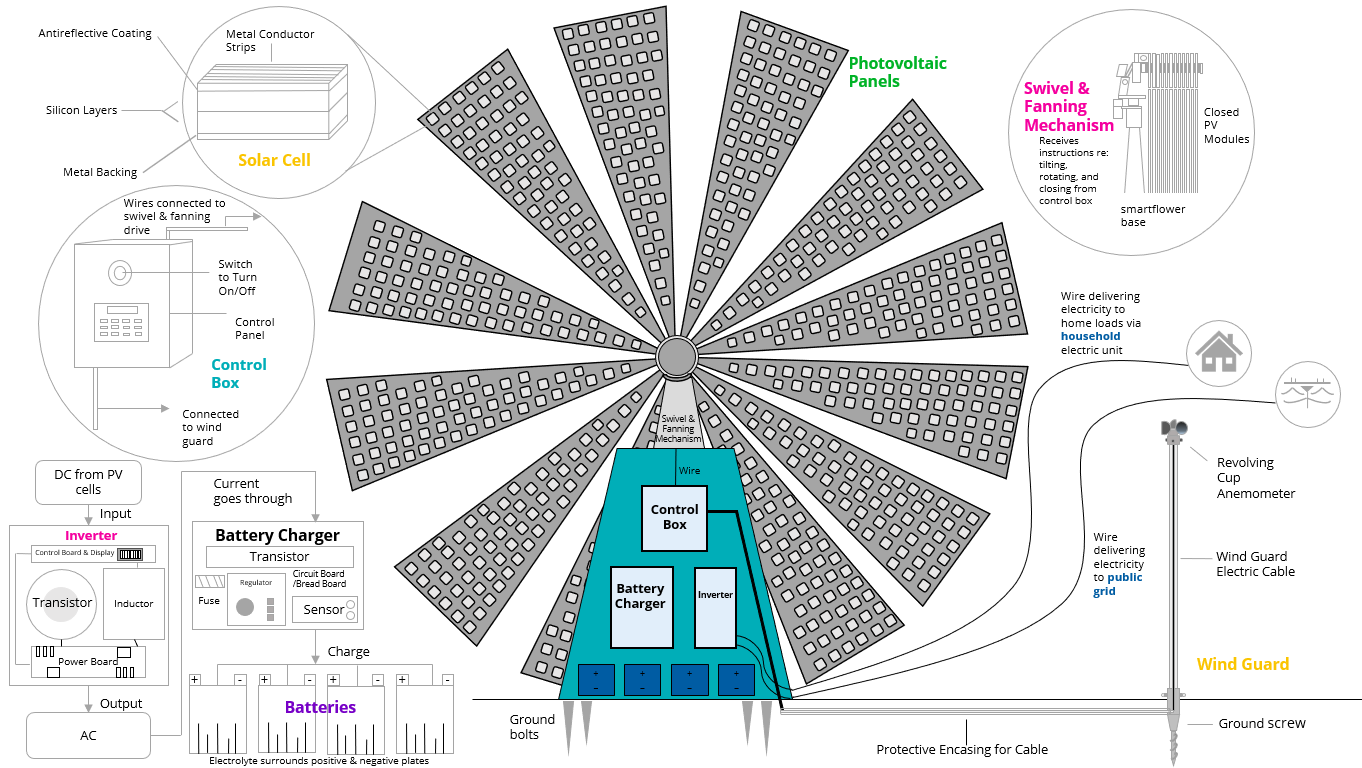Architecture
smartflower is an all-in-one solar system that harnesses energy from the sun’s rays to produce electricity. Its twelve photovoltaic panels form the shape of the petals of a flower.
smartflower’s photovoltaic (PV) panels are made up of monocrystalline solar cells. In a typical solar cell, two layers of silicon comprise most of each cell. One layer is infused with phosphorus and one with boron so that an electric field forms where the layers meet.
When sunlight hits the cell, electrons begin darting around the layers. Electrons that reach the electric field are propelled out through the metal conductor strips atop the cell. These metal strips conduct the flow of electrons through a wire to an inverter. Using transformers, the inverter converts the direct current (DC) emanating from the PV cell into alternating current (AC) that flows out of smartflower to power electrical appliances. Inductors and capacitors regulate the pace of the output current. Electrons also flow back out of the appliances and form a closed loop by returning through the PV cell’s metal backing, maintaining the flow of electricity. Excess electricity is stored in smartflower’s batteries, either for later use by the household or to be fed into the public grid.
The aforementioned PV panels activate when the smartflower user presses the power button in the control box during the installation process. The control box also contains the control panel, which requires a one-time, manual input of the GPS coordinates, date, and time of the location where smartflower has been installed.
This information, along with data collected by smartflower’s sensors, is used to direct the motion of the swiveling & fanning mechanism. This tracking mechanism consists of a base support, a rotary table, a swivel plate, and a fanning shaft on which the solar panels are mounted. The rotary table bears one end of the swivel plate. Nearby, a crank is linked via a connecting rod to the other end of the swivel plate. This coupling forms a four-bar linkage, which is a simple and useful mechanism for converting one type of motion into another. Once the swiveling & fanning mechanism receives its instructions from the control box, it adjusts the panels so they consistently align with the sun at an angle of 90 degrees throughout the duration of the day.
When the sun sets, smartflower’s sensors detect this occurrence and the swiveling & fanning mechanism folds the panels downward. smartflower’s PV panels then reopen when the sun rises. Whenever smartflower closes or opens, its panels rid themselves of any debris, dust, or snow using bristles that wipe the adjacent panels clean. This self-cleaning process contributes to smartflower’s ability to sustainably provide consistent energy over longer time horizons than stationary solar panels.
smartflower’s wind guard is a separate piece of equipment typically installed several feet from smartflower’s base. The wind guard consists of a revolving-cup electric anemometer attached to the top of a tall metal pipe. The metal pipe is fastened to a ground screw, which is drilled into the ground to keep the pipe upright. When the wind blows, the anemometer electronically sends a measurement of the wind speed through the underground wind guard cable to the control box.

